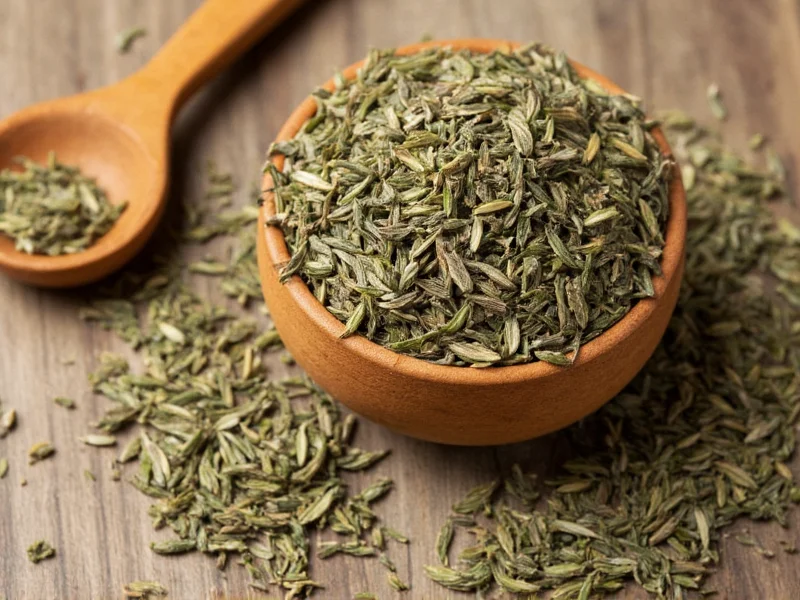Dried herbs are a kitchen staple that adds depth and complexity to countless dishes. While they won't make you sick like perishable foods can, understanding their shelf life is essential for maximizing flavor in your cooking. Unlike fresh herbs that wilt within days, dried herbs offer extended usability—but with important caveats about quality degradation.
How Dried Herbs Degrade Over Time
Drying removes moisture that bacteria and mold need to grow, making dried herbs inherently shelf-stable. However, the very compounds that give herbs their distinctive flavors and aromas—essential oils, volatile compounds, and pigments—are gradually lost through oxidation and evaporation. This process doesn't create safety hazards but significantly impacts culinary value.
The degradation follows a predictable pattern:
- First 6-12 months: Peak flavor and aroma
- 1-2 years: Noticeable decline in potency; may require using 25-50% more to achieve desired flavor
- 2-3 years: Significant flavor loss; primarily useful for visual presentation rather than taste impact
- Beyond 3 years: Minimal flavor contribution; may develop musty or stale notes
Factors Affecting Dried Herb Shelf Life
Several environmental factors accelerate the degradation process:
| Factor | Impact on Shelf Life | Optimal Condition |
|---|---|---|
| Light exposure | UV rays break down essential oils rapidly | Opaque containers or dark pantry |
| Temperature | Heat accelerates chemical breakdown | Cool environment (below 70°F/21°C) |
| Moisture | Triggers mold growth and clumping | Dry environment (below 60% humidity) |
| Air exposure | Oxygen causes oxidation of flavor compounds | Airtight containers with minimal headspace |
How to Properly Store Dried Herbs
Maximize your dried herbs' shelf life with these storage techniques:
- Choose the right container: Use glass jars with airtight seals rather than plastic bags. Dark glass (amber or cobalt) offers the best light protection.
- Minimize air exposure: Transfer bulk herbs to smaller containers as they're used to reduce the air-to-herb ratio.
- Avoid the spice rack next to the stove: Heat from cooking dramatically shortens shelf life. Store herbs in a cool, dark cabinet away from appliances.
- Never store above the refrigerator: This common spot experiences significant temperature fluctuations.
- Keep away from the sink: Humidity from dishwashing creates moisture problems.
Signs Your Dried Herbs Have Lost Quality
Unlike perishable foods, dried herbs rarely become unsafe, but these indicators show they've lost culinary value:
- Faded color: Vibrant greens turning dull brown or yellow
- Weak aroma: Rub between fingers—if you can't smell a distinct fragrance, potency is low
- Musty odor: Indicates moisture exposure and potential mold development
- Clumping: Sign of moisture absorption (discard if clumps are hard)
- Visible mold: White, fuzzy growth means immediate disposal
- Stale taste: Flat, cardboard-like flavor instead of characteristic herb profile
Shelf Life Expectations by Herb Type
Different dried herbs maintain quality for varying lengths of time based on their chemical composition:
| Herb Category | Examples | Optimal Shelf Life | Quality Indicators |
|---|---|---|---|
| Leafy herbs | Basil, oregano, thyme, mint | 1-2 years | Lose bright green color first; flavor fades gradually |
| Seed spices | Cumin, coriander, fennel | 3-4 years | Oils evaporate slowly; check aroma strength regularly |
| Root spices | Ginger, turmeric | 2-3 years | May harden; loses pungency more quickly than seeds |
| Woody herbs | Rosemary, sage, bay leaves | 2-3 years | Retain structure longer but lose aromatic compounds |
| Flower components | Saffron, chamomile | 6-12 months | Color and delicate aromas fade rapidly |
Practical Tips for Maintaining Herb Quality
Extend the useful life of your dried herbs with these professional techniques:
- Buy in small quantities: Purchase only what you'll use within 6-12 months for peak freshness
- Check harvest dates: Specialty stores often label when herbs were dried—choose the most recent
- Freeze for long-term storage: Properly sealed dried herbs can last 3-4 years in the freezer (thaw before opening to prevent condensation)
- Refresh stale herbs: Briefly toast in a dry pan to temporarily revive some aroma (works best for seed spices)
- Label containers: Note purchase or opening date to track freshness
- Store away from strong odors: Herbs readily absorb surrounding smells from coffee, onions, or cleaning products
When to Discard Dried Herbs
While dried herbs rarely pose food safety risks, discard them immediately if you notice:
- Visible mold growth (white, fuzzy patches)
- Musty or sour odors indicating moisture damage
- Significant clumping that doesn't break apart easily
- Exposure to flooding or significant moisture events
For herbs that have simply lost flavor but show no signs of spoilage, consider composting rather than throwing in the trash. Their organic matter still has value even when culinary usefulness has passed.
Maximizing Flavor from Aging Dried Herbs
If you're working with herbs past their prime, these techniques help extract remaining flavor:
- Add earlier in cooking to allow more time for flavor extraction
- Crush between fingers before adding to release remaining oils
- Use 25-50% more than recipe calls for (taste as you go)
- Combine with fresh herbs when possible for flavor boost
- Make herb-infused oils to concentrate remaining flavors











 浙公网安备
33010002000092号
浙公网安备
33010002000092号 浙B2-20120091-4
浙B2-20120091-4